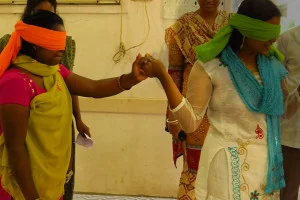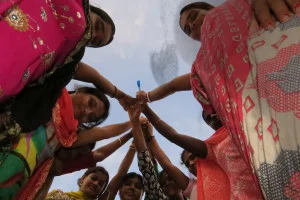Leadership of the New Era: From Survivors to Educators
A Brief Introduction
On 18th December, Smart Digital Classes were inaugurated in Balodabazar, Mahasamud and Janjgir Champa districts of Chattisgarh. These classes are specifically targeted to bring back students to school. The reason? The clearly existing digital divide that suspiciously runs along class lines have pushed hundred-thousands of students out of school during lockdown.rnChildren who have access to online modes of communication are making full use of this “extra” time granted by the gods to learn coding and algorithms alongside continuing their school curriculum. While we can see another picture of young children running along the streets of villages- older children becoming an extra pair of hands to earn money to sustain their families in the terrible economic slowdown that has been induced by the ill planned lockdown in India. The SMART Digital classes are specifically for those children who fall in the second category.
Who is doing this?
Sramik Adhikar aur Nyay Sangathan- in short, SAANS. Much like a breath of fresh air, SAANS’ initiatives are opening our eyes to new methods and approaches to organizing and informing migrant labourers in Chhattisgarh. This newly formed group which is not even a year old is made up of 7 leaders who were migrant labourers and survivors of labour trafficking. Aatmaram, Amrit, Anita, Dhananjay, Naina, Khemlal and Rama Sarathi are both leaders and members of this organization. To educate along class lines is their idea and execution.
The Vision
As their name suggests, SAANS wants to fight for rights and justice for workers. Leaders of SAANS are not the typical working-class organization one would come across. To begin with, they have been migrant workers themselves. How often can we say this about a leader of a mainstream working-class organization in India? Not often, one can be assured. SAANS leaders face multiple marginalities and thus understand the problems and needs of the marginalized. Throughout the lockdown and post lockdown periods, SAANS leaders started linking migrant workers in their communities with government schemes, distributed ration kits and started digital classes for children of migrant workers. The reason behind starting the digital classes was their first-hand observation of the children in their communities. They realized that these children were falling behind and getting out of touch with education. SAANS leaders aim to create more educational and professional opportunities for their community members.
Till now, 50 children have been enrolled in the SMART Education Centre in Balodabazar district. They come from five villages to the Centre, which is located in Dhourabhata. Students learn Mathematics, English, Science, Physical Education and Art. Apart from this, every Monday they have classes on Social Reform in India. Recently, they learnt all about Saviriti Bai Phule, social reformer, educationist and the first female teacher in India. If one enquires about the regularity of classes, they would be surprised to know that this centre runs 7 days a week! According to Amritlal Tilakiya, SAAN leaders and chief architect and educator of these classes, “If the children are eager to come on Sundays, who am I to stop them?”. Amrit has a long experience in teaching children. He has taught at many private institutions over the years but says that he used to work those jobs to be able to sustain himself. But this is not the case here. He is teaching voluntarily because he is passionate about imparting education for social transformation. He has designed many ways to teach his students the hardest of subjects through activities. He believes that children learn much better through actions. Recently he taught profit and loss by an elaborate game of MarketPlace. It is not a surprise that his students’ favourite subject is Mathematics!
Turning of tables
The smart digital class is a one-of-a-kind initiative in Chhattisgarh. SAANS leaders wanted to ensure the experience of SMART classes that most children of migrant workers would likely miss out on. Establishing education centers or institutes has a deep association with patronage. Moreover, education has been monopolized by brahmins in India for so long that even in modern India upper castes continue to enjoy their advantage in the field of education. Here, patronage is deeply related to caste locations. SAANS leaders remember Savitri Bai Phule ad Jyotirao Phule and their contribution towards the education of girls and dalits. SAANS leaders belonging to marginalized castes, having been migrant workers and survivors of trafficking and still opening an education center has created a unique reversal of existing structures of power in society. This turning of tables truly demonstrates that these structures can be won over and alternatives can be created and in fact, new mechanisms are being created in pockets and they can also be a part of the general reality.
How was this initiative made possible?
The images of migrant workers returning home after lockdown was imposed drew international attention. Migrant workers across the country were facing extremely dire situations and so fundraising initiatives were organized by civil society, political and social organizations. One such initiative was taken by the Indian Leadership Forum Against Trafficking (ILFAT), the first all India forum of survivors of trafficking. The money raised through this initiative was given to survivor collectives like SAANS to support migrant workers in their communities. SAANS leaders distributed ration kits to migrant workers in distress and vulnerable families and individuals in their communities. The other part of those funds was used to open the Smart digital education center for children of migrant workers.
Takeaways of the observer:
As the Youth Leadership Coordinator of Sanjog, the mentoring organization of SAANS, I have had the chance to interact with SAANS leaders since the inauguration of the classes. This initiative is their own and it is true to its very word. From cleaning and sanitization of the classroom, to inviting guests, to planning the inauguration event to deciding the curriculum-everything has been planned and executed by the leaders themselves. Very often can we see such autonomy of local level or grassroots activities while taking a big step as this.
Talking to Amrit about his experiences as a teacher makes me giddy with hope, but angers me at the same time. How is it that someone as passionate as him has remained an ‘untrained’ teacher in technical terms? How many more outstanding teachers have we missed because our socio economic system is one of exclusion? When will things change? Will we keep waiting for them to change?
SAANS is definitely not among those to wait. And hence, the need for more such initiatives becomes undisputed. More reasons are not required to justify why education must be made accessible to those who are excluded from it or why it is important to explore alternative methods to ensure justice for people who have been denied it. This process can be done and only be done by those to whom these changes are important and those who need them.rnrnSAANS leaders are going to be a force to reckon with as they have already started sowing the seeds of knowledge and inquiry in the minds of young people. One wise man had once said, “Education does not change the world, it changes people- and people change the world.”
Somashree Choudhury
|
Thursday
,
February 15, 2021


